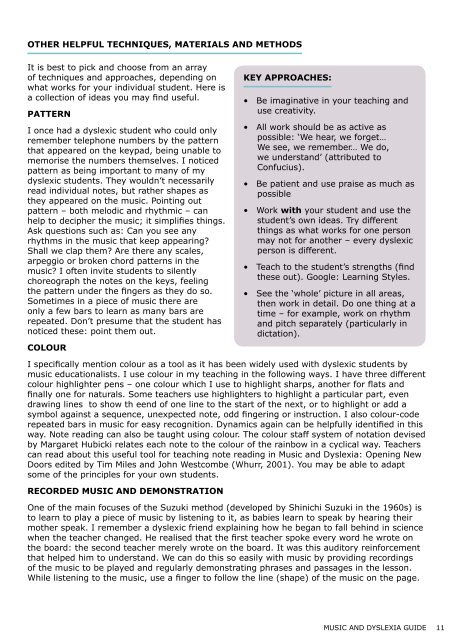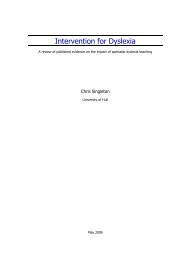TEACHER GUIDE TO MUSIC AND DYSLEXIA - Rhinegold Publishing
TEACHER GUIDE TO MUSIC AND DYSLEXIA - Rhinegold Publishing
TEACHER GUIDE TO MUSIC AND DYSLEXIA - Rhinegold Publishing
You also want an ePaper? Increase the reach of your titles
YUMPU automatically turns print PDFs into web optimized ePapers that Google loves.
Other helpful techniques, materials and methodsIt is best to pick and choose from an arrayof techniques and approaches, depending onwhat works for your individual student. Here isa collection of ideas you may find useful.PatternI once had a dyslexic student who could onlyremember telephone numbers by the patternthat appeared on the keypad, being unable tomemorise the numbers themselves. I noticedpattern as being important to many of mydyslexic students. They wouldn’t necessarilyread individual notes, but rather shapes asthey appeared on the music. Pointing outpattern – both melodic and rhythmic – canhelp to decipher the music; it simplifies things.Ask questions such as: Can you see anyrhythms in the music that keep appearing?Shall we clap them? Are there any scales,arpeggio or broken chord patterns in themusic? I often invite students to silentlychoreograph the notes on the keys, feelingthe pattern under the fingers as they do so.Sometimes in a piece of music there areonly a few bars to learn as many bars arerepeated. Don’t presume that the student hasnoticed these: point them out.ColourKey approaches:• Be imaginative in your teaching anduse creativity.• All work should be as active aspossible: ‘We hear, we forget…We see, we remember… We do,we understand’ (attributed toConfucius).• Be patient and use praise as much aspossible• Work with your student and use thestudent’s own ideas. Try differentthings as what works for one personmay not for another – every dyslexicperson is different.• Teach to the student’s strengths (findthese out). Google: Learning Styles.• See the ‘whole’ picture in all areas,then work in detail. Do one thing at atime – for example, work on rhythmand pitch separately (particularly indictation).I specifically mention colour as a tool as it has been widely used with dyslexic students bymusic educationalists. I use colour in my teaching in the following ways. I have three differentcolour highlighter pens – one colour which I use to highlight sharps, another for flats andfinally one for naturals. Some teachers use highlighters to highlight a particular part, evendrawing lines to show th eend of one line to the start of the next, or to highlight or add asymbol against a sequence, unexpected note, odd fingering or instruction. I also colour-coderepeated bars in music for easy recognition. Dynamics again can be helpfully identified in thisway. Note reading can also be taught using colour. The colour staff system of notation devisedby Margaret Hubicki relates each note to the colour of the rainbow in a cyclical way. Teacherscan read about this useful tool for teaching note reading in Music and Dyslexia: Opening NewDoors edited by Tim Miles and John Westcombe (Whurr, 2001). You may be able to adaptsome of the principles for your own students.Recorded music and demonstrationOne of the main focuses of the Suzuki method (developed by Shinichi Suzuki in the 1960s) isto learn to play a piece of music by listening to it, as babies learn to speak by hearing theirmother speak. I remember a dyslexic friend explaining how he began to fall behind in sciencewhen the teacher changed. He realised that the first teacher spoke every word he wrote onthe board: the second teacher merely wrote on the board. It was this auditory reinforcementthat helped him to understand. We can do this so easily with music by providing recordingsof the music to be played and regularly demonstrating phrases and passages in the lesson.While listening to the music, use a finger to follow the line (shape) of the music on the page.<strong>MUSIC</strong> <strong>AND</strong> <strong>DYSLEXIA</strong> <strong>GUIDE</strong> 11









